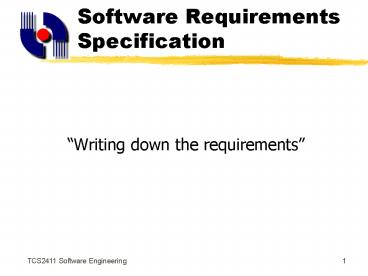Software Requirements Specification - PowerPoint PPT Presentation
1 / 20
Title:
Software Requirements Specification
Description:
To describe different methods of specifying the software ... and Design' by Jeffrey A. Hoffer, Joey F. George & Joseph S. Valacich, Benjamin/Cummings, 1996 ... – PowerPoint PPT presentation
Number of Views:87
Avg rating:3.0/5.0
Title: Software Requirements Specification
1
Software Requirements Specification
- Writing down the requirements
2
Lecture Objectives
- To describe different methods of specifying the
software requirements - To illustrate the use of technical methods for
specifying certain types of requirements - To describe the properties of good software
requirement specifications
3
Software Requirements Specification
- From our understanding of the problem, we now
write down what the customer wants from the
software - Documentation of what the software is supposed to
be - Many companies regard it as contract between
customer and developer - The basis for validation and verification
4
Using Natural Language
- More than 50 of the content of the
specifications are usually written using plain
English, Bahasa, Chinese, etc. - Easy to produce
- Easy for customer to understand
- Can be improved by using structured form, using
fields and description placed in fields
5
Examples of Specifications
- The printout of outstanding creditors are done
monthly at the end of each month. - Purchase orders are automatically generated when
the item quantity reaches below the reorder
level. - Usually the report is produced based on the code
given.
6
Problems of Natural Language
- Lack of clarity
- Words such as some, usually, probably
- Ambiguity
- Some words have more than one meaning
- Context dependency
- Same word in different sentences have different
meaning - Depends on whole paragraph/page/document
7
Using Diagrams
- Graphical representation of the analysis can
present the information better using - Entity-Relationship Diagrams
- Data Flow Diagrams
- State Transition Diagrams
- event table, action table
- Decision Tables
- Decision Trees
8
Decision Tables
- Representation of logic that is part of the
processing - Based on a set of conditions, different actions
will be performed - Can be simplified by removing impossible actions
9
Structure of Decision Table
10
Example of Decision Table
11
Constructing Decision Table
- Name the conditions and the values each condition
can assume - Name all possible actions that can occur
- List all possible rules
- Define the actions for each rule
- Simplify the decision table
12
Simplified Decision Table
13
Decision Trees
- Graphical technique representing decisions using
a series of nodes and branches - Each node is a decision point - a choice has to
be made - Each branch has a corresponding value to the
decision choice - Subsequent action is the result
14
Example of Decision Tree
Pay base salary
Yes
1
No
Yes
Pay hourly wage Absence report
2
No
Pay hourly wage
Yes
3
Legend 1) Salaried? 2) Hours worked lt 40? 3)
Hours worked gt 40?
No
Pay hourly wage Pay overtime wage
15
Mathematical Methods
- Implicit Equations
- Specific equations relevant to software
- Includes other equation details e.g. data type,
matrix size, algorithm - Regular Expressions
- To specify syntactic structure of string codes
- Example ltidgt ltyrgtltcoursegtltnumbergt
- ltnumbergt ltdigitgtltdigitgtltdigitgtltdigitgt
- ltdigitgt 0 1 2 3 4 5 6 7 8 9
16
Mathematical Methods (Continued)
- Recurrence Relations
- Consist of initial part and one or more recursive
parts - Example Fibonacci sequence
- F(0) 1
- F(1) 1
- F(N) F(N-1) F(N-2) Ngt2
- Useful for generation of repeated items, e.g.
account number
17
Advanced Mathematical Methods
- Axiomatic Definition
- specify basic system properties (axioms) and how
the system generate new properties - Example
- REPLACE(stk,itm) if EMPTY(stk) then error else
(PUSH(POP(stk),itm) - Formal specifications
- Use of mathematically based techniques
- Sets, Operators, Sequences, Logic Operators
18
Good Specifications
- Correct
- Complete
- Consistent
- Unambiguous
- Functional
- Verifiable
- Traceable
- Easily changed
19
Traceability Methods
- All requirements should be assigned a unique
number - Requirements should explicitly identify related
requirements by referring to their number - Each requirement should contain a cross-reference
matrix showing related requirements
20
References
- Software Engineering A Practitioners Approach
5th Ed. by Roger S. Pressman, Mc-Graw-Hill, 2001 - Software Engineering by Ian Sommerville,
Addison-Wesley, 2001 - Modern Systems Analysis and Design by Jeffrey
A. Hoffer, Joey F. George Joseph S. Valacich,
Benjamin/Cummings, 1996































